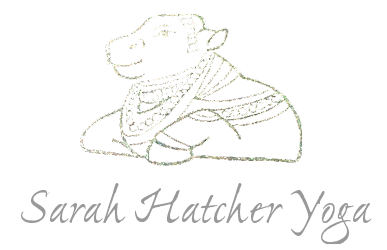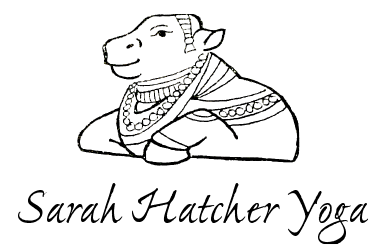Finding Yoga in a Bookstore
When I began yoga, I knew there was something magical about it. The year was 1995, and I was in Truckee, California. I happened upon a used book store by the river. I remember opening the squeaky door with the bell on it…and there right in front of me was this magical treasure, a tattered used soft back, “Yoga for Women”. The cover had a picture of a woman sitting in lotus with different colours painted along her spine (the chakras). I practically read the whole thing standing right there in the shop. “Well I should probably buy it”, I said to myself, “this is amazing.”
It was a $1.50.
I did everything in the book that whole year and good thing I did as I was having the hardest year of my young life. I had moved up to Truckee so that I could be closer to my mountains of Lake Tahoe and train exclusively for ski racing, which I was seeking to land a spot on the US Ski Team and progress my skill.
This did not happen. What did happen was that I got very isolated from my parents and my friends; I went into a very internal time - I stopped eating the food I was normally being cooked and started looking at health fads - nutrition that would make me stronger. I didn’t do myself any favours when I took out all “fat” from my food and began over-training, not getting enough rest and quite simply, wearing myself down.
Alpine skiers need powerful legs and lots of stamina to sustain the weight bearing and very technical physicality the sport demands. I became smaller and smaller as the season progressed and eventually, found myself injured with a stress-fracture in my tibia, one that sheared up my shin bone all the way from my root of the bone to my patella. It look six months to heal.
I quit skiing, I moved back in with my parents and finished my senior year at Reno High School. I met some new friends, connected with old ones, and started over. I went back to swimming and playing soccer and I started climbing and white water kayaking; I also got involved in my schools’ social action and environmental clubs. In many ways quitting competitive skiing woke me up to the world around me, and I was much more of a participant in my surroundings. Being back in a comfortable place, my relationship with food became healthy again and I learned how to nourish myself and my thoughts. I had to: I was at rock bottom. I had lost my sport, my vision and my dream: there was no where else to go but up.
I found a yoga teacher named Lee Burgen; she was quite possibly the reason I didn’t go off the deep end. Lee taught me Hatha yoga - the breathing and the relaxing postures taught me how to soften and sit. To watch and to listen. I didn’t mind that I was the only teenager in the room amongst the adults at her home. It was a luxury to take her classes once a week and I found myself spending more and more time on my own practicing.
Injuries continued to plague my sporting endeavours: just before heading off to University I tore my ACL playing soccer in a pick-up game. This injury had to do with that same stress fracture a year before - it just didn’t heal quite right. I looked more and more to the yoga practice I was learning and again sought to listen more.
The yoga stayed, like quiet background music to the play, it was always there. Curious and soothing, it never went away, even on days when it didn't feel good at the beginning, it always rewarded me after with thoughts of clarity and ease.
While at the University of Oregon, I saw a demonstration of ashtanga yoga. I had no idea what it was called, I just knew this was the style I had to learn. The sound of the breath was audible and the focus and concentration around the yogi was palatable.
From when I first started hatha yoga in 1995 from my little used book to when I began dipping my toe into ashtanga in 2000, it wasn’t really until 2004 that I finished the primary series. It took me all that time to uncouple what I had done to my body: heal my knees, grow my inner self and quite possibly, unlearn what I thought was a healthy body and mind. To be completely honest, I am still doing this today.
Have a listen to the Ashtanga Yoga closing prayer - the Mangala Mantra below - may it remind you that no matter what level of yoga you are at or where you are practicing right now, your first yoga experience and what led you towards practicing - is the reason to do it! And may this memory call you back into daily practice if you’ve lost it. May your yoga story encourage you to keep returning to the mat over and over as the years go on, as it does for me. And may that curiosity about what yoga is continue to draw you back to the mat each and every day, as it does for me.
Even though that rocky, isolating and painful year in Truckee had a huge impact on my life - I will always be grateful that I found yoga waiting for me in a bookstore.
Join me online for a workshop THIS Saturday, 27 March at 8 am, “Spring into Aṣtānga Yoga” where we will have a detailed look at the relationships of the primary and intermediate series - we will look at patterns in our bodies where we have woven unfriendly relationships and find ways say goodbye to some and hello to others. There is a booking link below. Also here is a wee description of why I feel we need both series in our lives for balance and rejuvenation. Enjoy!
A detailed description of the workshop ahead:
The primary series teaches us how to pacify the nervous system and listen to our breath. It consists mostly of forward bends, hip openers and some backbends. There are roughly 45-50 upward dogs and 2 backbending postures in the series, so we can't really say there isn’t a lot of backbending. This series is governed by the exhalation breath since most of the postures are forward bends and we enter each pose via an exhale and these are countered with a repetitive upward dog inhalation vinyasa where we hold the upward dog for only one breath.
Depending on who you talk to or who you have learned from, one usually starts the intermediate series only when they have 1), bounded their hands in Marichyasana D, 2), bounded their hands in Supta Kurmasana, and 3), come up to standing from the position of Urdvha Dhanurasana (coming up from the floor). You may also hear that one is ready for the intermediate once they have done the primary series 1,000 times. I started the intermediate series after I had been doing the primary series for four years.
The Intermediate series is a whole different energy entirely - most of the postures are entered from an inhalation - however not always, and are replicas of parts of the primary series postures though many are from another realm altogether. The main themes of the Intermediate series - or Nadhi Shodhana, is Backbending, Leg Behind the Head poses and Arm Balances. Though there are finer notes about this series these are the basic actions that govern the series.
To link both series in a given week is a good idea for all long-term practitioners because one receives a balancing effect from each series. One receives the therapeutic benefit of the forward bending poses of primary series - pacifying the nervous system and aiding in digestion and elimination with the many postures of Marichyasana, and also by practicing intermediate series, one enhances their life force by building the inhale breath with deep backbends, opening our hips further and balancing on our arms which gives us courage, fortitude and stamina.
If you are just starting the Intermediate series, don’t be afraid to modify it, adjust it and skip poses that don’t work for you - like a jigsaw puzzle, do parts of it carefully with the guidance of a teacher and then arrange the pieces together by adding the more difficult parts in with time.
Practicing Dhanurasana, in Boise Idaho, 2009.


